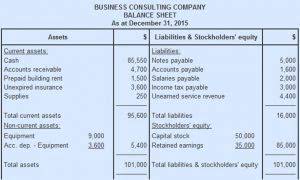
If the accounts payable are $88,000 they will be restated as 22% ($88,000 divided by $400,000). If owner’s equity is $240,000 it will be shown as 60% ($240,000 divided by $400,000). The vertical analysis of the balance sheet will result in a common-size balance sheet. The percentages on a common-size balance sheet allow you to compare a small company’s balance sheets to that of a very large company’s balance sheet. A common-size balance sheet can also be compared to the average percentages for the industry.

Vertical Analysis for Income Statements

In order to do a vertical analysis of a company’s cash flow statement, you will need to divide each item by the total net cash from operating activities. This will give you the percentage of that particular item as it relates to the total. You can then compare this information over time to track changes in performance. In order to use the vertical analysis equation, you need to figure out your base figure. On a business’s balance sheet, you can find the relevant base figure as the company’s total assets or liabilities.
- From a costs perspective, we can see a big increase in total expenses.
- We can gather from the data below that the sales of the company increased consistently from year 1 to year 3.
- When looking at the financial statements of your business, it can get quite confusing due to the different figures used.
- The below vertical analysis example helps to understand the comparison.
- Analysis of trends over time to evaluate performance improvements or declines.
Company Valuation: How to Value Your Business?
- If you are looking to perform this type of analysis on your spreadsheet for either the income statement or cash flow statement.
- And then working out each transaction that is recorded in your financial books as a percentage of that figure.
- On the income statement, our base amount is going to be our net sales.
- I’ll write a couple of these out and then we’ll see, that it’s very much the same as what we did.
- One of the pros of vertical analysis is that it allows for the comparison of financial statements from one accounting period to the next as well as for comparisons among different companies.
- As you can see there is a heavy focus on financial modeling, finance, Excel, business valuation, budgeting/forecasting, PowerPoint presentations, accounting and business strategy.
By doing so, we can analyze the proportions and relationships between different components of the income statement. Vertical analysis makes it much easier to compare the financial statements of one company with another and across industries. This is because one can see the relative proportions of account balances. In the above vertical analysis example, we can see that the income decreases Bookkeeping for Painters from 1st year to 2nd year, and the income increases to 18% in the 3rd year. So by using this method, it is easy to understand the net profit as it is easy to compare between the years. We can easily understand that the total expenses gradually increased from 43% to 52%, and the net income get reduced from 1st year to 2nd year.

SaaS Financial Model Template
- That means for every dollar of sales, well, we’re keeping 8.8% from operations, and then we’ve got a couple more things we got to pay for, and then we’re left with our net income.
- Before that, though, the first step is to get the company’s income statement.
- The income statement also uses this presentation with revenue entries referencing total revenues and expense entries referencing total expenses.
- Vertical analysis can highlight whether these changes are proportional.
- In a booming market, it could suggest missed growth opportunities.
- To increase the effectiveness of vertical analysis, multiple year’s statements or reports can be compared, and comparative analysis of statements can be done.
A vertical analysis is still dealing with percentage changes, but we’re not dealing with year over year changes anymore. We’re going to be dealing with a percentage of the base amount on the financial statement. So we’re going to do this for the income statement and the balance sheet.

Key Learning Points
Financial statement items are reported as percentages of one another to facilitate vertical analysis. This step is taken in order to ensure that the analysis is carried out in the most thorough manner possible. However these expenses, at the first glance, don’t seem to be significant enough to account for the large fall in net income in year 3. Proportional analysis of financial statements at a single point in time. Additionally, since the calculations are relatively simple, it is a great way for beginners to understand financial statements and start their own analysis. Finally, since vertical analysis the calculations are relatively simple, it is a great way for beginners to understand financial statements and start their own analysis.
It enables the accountant to see relative changes in company accounts over a given period of time. The analysis is especially convenient to do so on a comparative basis. Vertical analysis is most commonly used within a balance sheet financial statement for a single reporting period, e.g., quarterly. It is done so that accountants can ascertain the relative proportions of the balances of each account.
